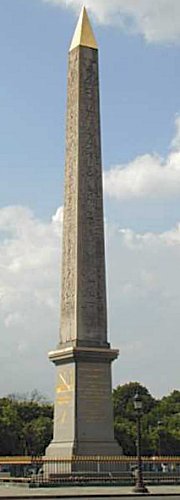 |
In fact, the obelisks from Luxor are anything but small. In a land of gargantuan monuments, these obelisks tower above others of their kind at a height of 82 feet (25 meters). Both were carved from red granite and engraved with three vertical lines of inscription repeating the names and titles of Ramses the Great: "The Horus, Mighty Bull, Exalter of Thebes, Favorite of the Two Goddesses, establishing monuments in Luxor for his father Amun, who placed him upon the throne; Golden Horus, seeking excellent things for him who fashioned him; King of Upper and Lower Egypt, Usermaatre, Setep-enre, may he be given life."
Throughout pharonic history it was common practice for the reigning pharaoh to appropriate some of the monuments of his predecessors by removing the old king's name and inscribing an extended or refurbished structure with that of the new king. Ramses is famous — and sometimes criticized — for it. It's an interesting reflection on this great pharaoh's view of the future to note that when the obelisk was removed from its pedestal for shipment to France, Ramses the Great's shenou — or cartouche — was found carved on the bottom of the obelisk. He obviously intended that, whatever might happen with future reigns, these red granite obelisks would forever be his own.